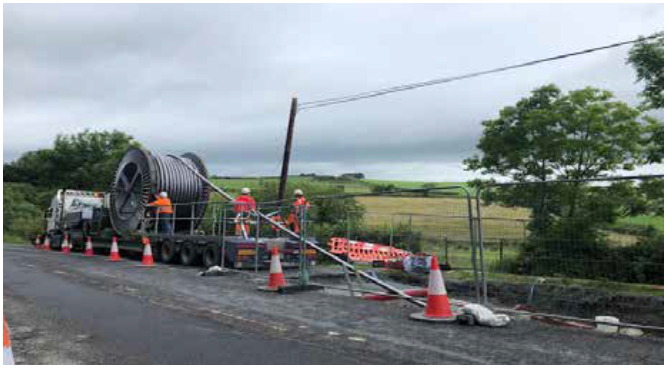About the Underground Cable
About the Underground Cable
The cable that will be used is high-voltage XLPE cable with copper or aluminium core, installed within underground plastic ducts. This technology for electricity transmission is proven across Ireland and internationally.
What does underground cable construction involve?
As this project progresses, we will consult and work closely with local communities and businesses to minimise disruption that may be caused by construction. The photos shown here provide a typical example of what construction may look like. We will be able to provide more information on the construction process as the design progresses.
Construction is broken down into three steps.
Step 1:
Trenches are dug for plastic ducts and larger openings for joint bays. Joint bays are installed below ground to allow for joining different sections of the cables at up to 750 metre intervals. This interval depends on constraints and space. A typical joint bay is 2 metres deep, 2.5 metres wide and 8 metres long, with a slightly larger footprint required for construction.

Figure 2: A typical cable duct installation in the road

Figure 3: A typical jointing bay where cables are connected

Figure 4: Cables being pulled into the ducts and jointing bay

Figure 5: A typical passing bay in operation during cable jointing
Beside the joint bay is a link box and a C2 box.
Link box – The link box is used to test and provide a point for condition assessment and maintenance of the cables for performance and reliability. The link box looks like a small manhole.
C2 box – This is a small chamber where communication cores are connected. These cores transmit signals to and from our substations to ensure that the cable is protected and working as designed. We then return the surface to its original appearance.
Step 2:
The cables are delivered to a section of the site on cable drums. Two working areas are set up at each end of the trenched section, at the joint bays. At one end, the cable feed is placed, and at the other, the equipment to pull the cable through.
Step 3:
Cables are pulled through in sections and connected as one circuit in a process called jointing. This process is carried out in an environmentally controlled enclosure which fits directly over the underground joint bay which is exposed for access. Once installed, the road surface is returned to its, the surface is returned to its original appearance and the joint bays are completely hidden from view.
Off-road corridors
It may be necessary to consider off-road sections to provide flexibility if we meet any challenges. These off-road corridors are still in the discovery phase but may include North Park in preparation for underground crossings of the M50, Tolka Estuary Greenway and the Royal Canal Greenway.
Traffic management
Before works begin, road licenses and traffic management plans will be secured and agreed with the relevant local authorities. This could include road closures and traffic diversions. This ensures the safety of road users and those carrying out the work.
Larger road closures allow for greater speed in the construction and will be assessed with the local authorities in advance. Local access to homes and businesses will be maintained at all times. Our Community Liaison Officers will work closely with local communities and businesses throughout the work.
Advanced ducting
Advanced ducting involves completing ducting works while other organisations are completing similar works within an area. While we make every effort to collaborate on project, it can often be difficult to align projects.
We are currently exploring options on the Royal Canal Greenway as an opportunity to lay ducts in collaboration with the National Transport Authority, and along Alexandra Road with Dublin Port.